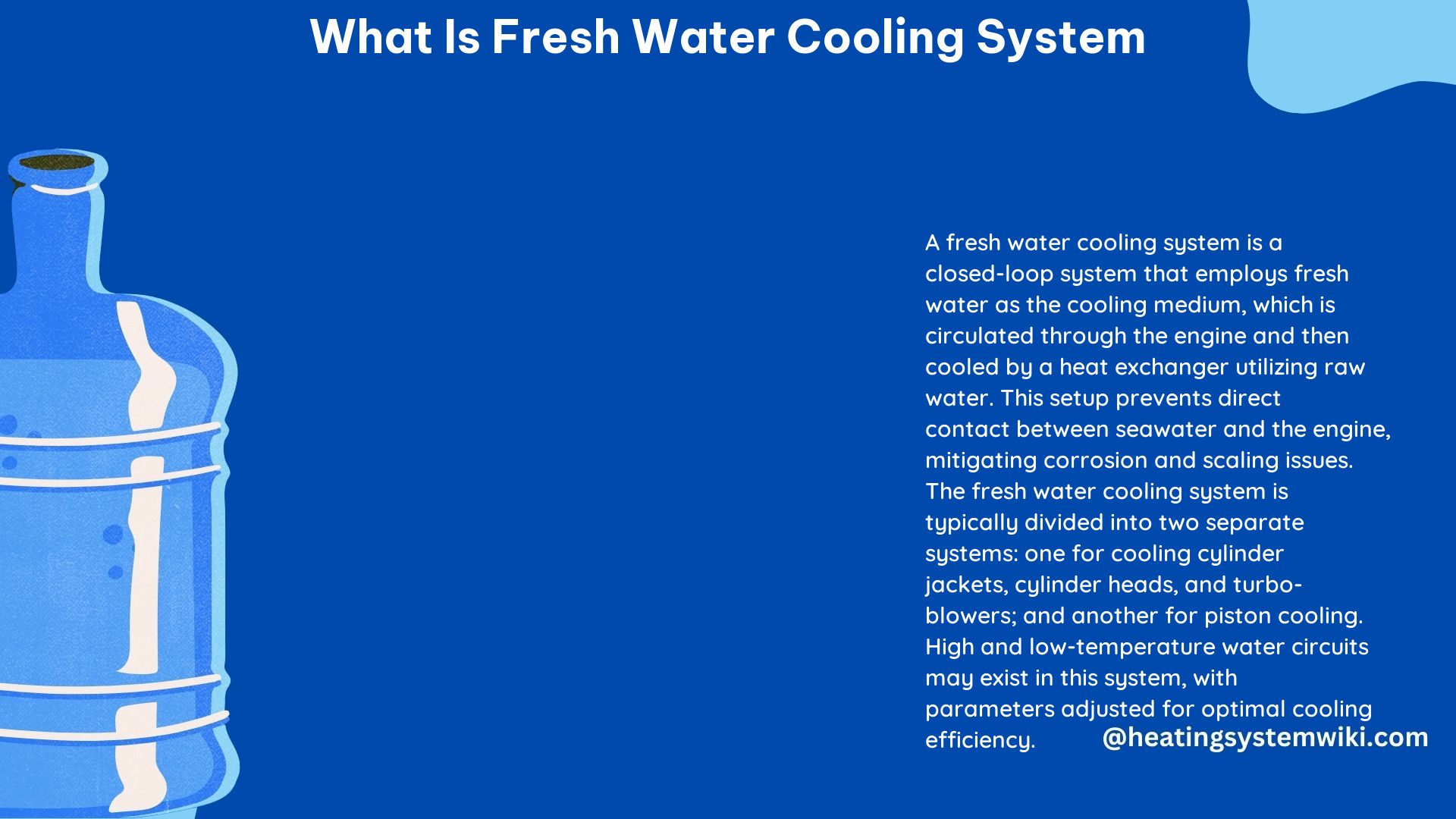A fresh water cooling system is a type of engine cooling system that uses a combination of fresh water and coolant to absorb the heat generated by the engine. This system is commonly used in newer marine engines and is considered to be more advantageous than raw water systems, especially in saltwater environments.
Understanding the Fresh Water Cooling System
The fresh water cooling system is divided into two separate systems: one for cooling the cylinder jackets, cylinder heads, and turbo-blowers; and the other for piston cooling.
Cylinder Jacket Cooling System
- The cylinder jacket cooling water, after leaving the engine, passes through a sea-water-circulated cooler and then into the jacket.
- It is then pumped around the cylinder jackets, cylinder heads, and turbo-blowers.
- A header tank allows for expansion and water make-up in the system.
Piston Cooling System
- The piston cooling system employs similar components, except that a drain tank is used instead of a header tank.
- The vents are led to high points in the machinery space.
- A separate piston cooling system is used to limit any contamination from piston cooling glands to the piston cooling system.
Advantages of Fresh Water Cooling System

In a fresh water cooling system, the raw water is also pumped through the heat exchanger where it absorbs some of the heat of the fresh water and is again discharged overboard. This system is more advantageous than raw water systems because it:
- Prevents the build-up of corrosive scale inside the engine’s water jacket and ports, which can restrict water flow and cause the engine to overheat.
- The water that flows through the engine’s water jacket and ports is the fresh water and coolant, while the raw water only flows through the heat exchanger.
- If water flow is restricted and the engine begins to overheat, only the heat exchanger may need to be replaced, which is much less expensive than replacing the entire engine.
Other Components of the Cooling System
Other components of the cooling system, whether it be raw water or fresh water, include:
| Component | Description |
|---|---|
| Seacock | A through-hull device that allows water to enter the hull from the outside. It has a handle that allows you to shut off the water flow if you have a problem such as a loose hose clamp. |
| Sea Strainer | Filters out debris and contaminants from the raw water before it enters the cooling system. |
| Hoses and Clamps | Responsible for transporting the cooling water throughout the system. |
| Belts | Drives the water pump that circulates the cooling water. |
| Water Pump Impeller | Responsible for pumping the cooling water through the system. |
It is important to regularly inspect and maintain these components to ensure the proper functioning of the fresh water cooling system.
Maintenance and Troubleshooting
To ensure the proper functioning of the fresh water cooling system, it is important to:
- Test the seacock shut-offs monthly to make sure they are operable.
- Have a soft, tapered, wooden plug (called a bung) of the size of the seacock tied to the seacock as a backup safety measure.
- Regularly clean the sea strainer to prevent debris and contaminants from entering the cooling system.
- Check the hoses and clamps for any signs of wear or damage and replace them as needed.
- Inspect the belts for proper tension and replace them if they show signs of wear or cracking.
- Replace the water pump impeller at the recommended intervals to ensure efficient water circulation.
By following these maintenance and troubleshooting steps, you can ensure the longevity and optimal performance of your fresh water cooling system.
Conclusion
In summary, a fresh water cooling system is a type of engine cooling system that uses a combination of fresh water and coolant to absorb the heat generated by the engine. It is more advantageous than raw water systems, especially in saltwater environments, because it prevents the build-up of corrosive scale inside the engine’s water jacket and ports. The system is divided into two separate systems: one for cooling the cylinder jackets, cylinder heads, and turbo-blowers; and the other for piston cooling. The raw water is also pumped through the heat exchanger where it absorbs some of the heat of the fresh water and is again discharged overboard. Other components of the cooling system include the seacock, sea strainer, hoses and clamps, belts, and water pump impeller. Regular maintenance and troubleshooting of these components are crucial for the proper functioning of the fresh water cooling system.
References:
– Engine Cooling Systems Explained – Discover Boating
– Fresh water & Sea water Cooling System for Marine Diesel Engine
– Seawater & Fresh Water Cooling System – Grano
– Is fresh water cooling the way to go – Boating and Fishing Forum
– Ship’s Fresh Water Cooling System | Study Call Ep 003 Chief MAKOi
